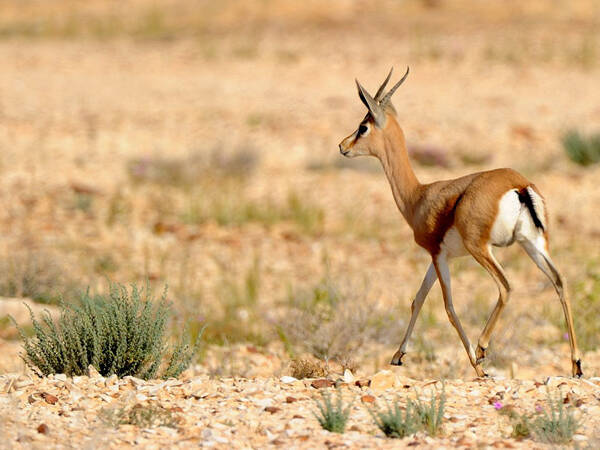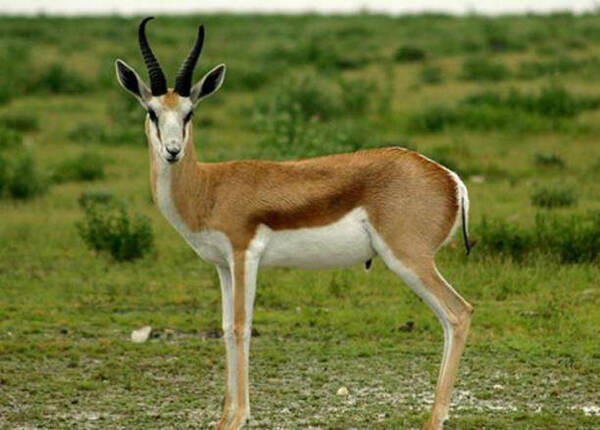Gazella dorcas
IUCN
LCBasic Information
Scientific classification
- name:Gazella dorcas
- Scientific Name:Gazella dorcas,Dorcas gazelle
- Outline:Ungulata
- Family:Artiodactyla Bovidae Gazelle
Vital signs
- length:90-110cm
- Weight:15-20kg
- lifetime:About 15 years
Feature
One of the most desert-adapted gazelles may never drink water in its entire life
Distribution and Habitat
Algeria, Chad, Djibouti, Egypt (Sinai region), Eritrea, Ethiopia, Israel, Jordan, Libya, Mauritania, Morocco, Somalia, Sudan, Tunisia, and western Sahara.
Possibly extinct: Nigeria.
Uncertain: Burkina Faso.
Extinct and reintroduced: Senegal.
Found throughout savannah, semi-desert, and true desert areas of North Africa and western Arabia, preferring arid and semi-arid habitats. This gazelle avoids large areas of sand dunes and overly arid areas. It preferentially inhabits rocky plains with sparse vegetation, including savannah, semi-desert, small dune fields, consolidated dune areas, and dry river valleys.
Appearance
The deer gazelle is 90-110 cm long, 55-65 cm tall at the shoulder, and 15-20 cm long tail; it weighs 15-20 kg. It is the second smallest gazelle species. It is similar in appearance to the mountain gazelle, but is smaller and has longer ears. Both sexes have lyre-shaped and ridged horns, with the most pronounced curve of the gazelle members. The male's horns curve back and upward at the tip, and the degree of curvature varies within the subspecies. The male's horns are 250-280 mm long and have 20-24 ridges. The female's horns are smaller and straighter, 170-190 mm long, with 16-18 ridges. The preorbital glands, although functional, are not used for marking.
The upper body fur is light beige or sandy red, with white underparts and rump. There is a broad brownish-red stripe on the underside between the front and hind legs, forming a border that separates the white belly and upper body fur. The head and body are the same beige color. There is a white eye ring, and a pair
Details
Deer gazelle (scientific name: Gazella dorcas) foreign name Dorcas Gazelle, there are 6 subspecies.

Adult male deer gazelles are territorial and will deposit feces within their territory. These feces are deposited in a striking display, with males first making footprints on the ground, then urinating in the scraped area, crouching on the ground to excrete and deposit the feces. The species can withstand higher temperatures and in hot weather they are mainly active at dawn, dusk and throughout the night. Herds of gazelles wander over large areas in search of food and tend to congregate in areas where recent rainfall has stimulated plant growth. The species lives in groups consisting of one adult male, multiple females and young. The range is approximately 25 square kilometers. Activity patterns depend on the severity of the climate. In hot summers, these gazelles are mostly active at dawn and dusk. With moderate temperatures, they can be active all day. In environments where daytime predators are prevalent, they may also be active at night. Depending on the climate, females travel in pairs or in groups consisting of 1-2 males and up to 4 females and their young. Sometimes males travel in bachelor groups of 4-5 individuals.
The alarm call of the Stag gazelle sounds like the quack of a duck and is produced through the nose, which expands in the process in a manner similar to that of the Stag gazelle, although less prominent. The call of the gazelle sounds like a short bark. They also become more vocal in situations of extreme danger or pain. Females make low grunts to call their young, while all deer gazelles make a long growl to indicate annoyance. When threatened by a predator, the "stomping" described in the hunting section is a common way to alert other gazelles to the presence of a predator. Gazelles rely primarily on their keen eyesight to monitor predators. In addition to using sounds to alert other companions, they also use body language, such as skin shivers, tail twitches, and high jumps with the head raised (also known as a straight jump), to warn others of the presence of a predator. Deer gazelles can run at speeds of up to 80 kilometers per hour. When threatened, their tails will quiver and they will repeatedly raise their heads and jump to alert their companions.

In many of the areas where they live, the antelope feeds primarily on the flowers, leaves, and pods of the acacia tree. It also feeds on the fruits and leaves of various shrubs. In the Negev Desert, the antelope feeds on Madonna lilies (also known as King Spring Grass, Pancratium sickenbergeri). The method of obtaining food varies depending on the season. In summer, deer gazelles dig holes in the sand to feed on the stems and bulbs of Madonna lilies. After the winter rains, they eat the newly sprouted leaves. The foraging technique allows for maximum energy absorption with minimum energy output. The bulk of the feeding is done in small areas with high concentrations of plant life, followed by long migrations to other food areas. As one of the most desert-adapted gazelles, deer gazelles may never drink water throughout their lives, but instead obtain all the water they need from the plants they eat.
The mating season for deer gazelles is generally from September to November. In the wild, about 90% of wild females begin breeding at around 2 years of age, and only one calf is born per litter. The gestation period lasts about 6 months, and the fawns are born with fur and their eyes open. The young spend most of the first two weeks curled up in the shade. After that, they follow their mothers around in search of solid food. Males do not seem to participate in caring for the young, except indirectly by protecting the group's resources. The female nurses her young for 1-2 minutes at a time, several times a day, for about 3 months. During the first two weeks of the young's life, the mother will leave the young in a safe place when she needs to graze. As the young grow, they join the herd in which they were born. In captivity, gazelles can live up to 15 years. The average lifespan in the wild is unknown and may vary between populations.

Data compiled in 1999 indicated that the number of deer gazelles in sub-Saharan Africa was between 35,000 and 40,000, with a total population of tens of thousands. Except in areas with low hunting pressure, the number of deer gazelles in other areas has generally declined. In 2005, it was reported that the number of species was in a downward trend in almost all distribution ranges, and it was noted that deer gazelles had disappeared in many areas and the number of surviving deer gazelles was seriously reduced. The largest populations of the species are found in Chad, especially in the Ouadi Rimé-Ouadi Achim Faunal Reserve, and in Niger in the Aïr-Ténéré National Nature Reserve and Termit Massif-TinToumma. In Morocco, the wild population is estimated at 800-2000 individuals (2007). In Israel, the population is estimated to be over 2000 and stable (2001). In Egypt, the population of 1000-2000 is rapidly declining, mostly outside protected areas (2001). There are no reliable population estimates for Algeria, Tunisia and Libya, although it is unlikely that the population exceeds 1000 individuals (2013). A survey of the Termit Massif in Niger estimated the population at 3000 individuals (2008).
Listed in the IUCN Red List of Threatened Species in 2016 ver3.1 - Vulnerable (VU).
Listed in the CITES III level protected animals of the Washington Convention. (Species distributed in Algeria and Tunisia).
Protect wild animals and eliminate game.
Maintaining ecological balance is everyone's responsibility!








